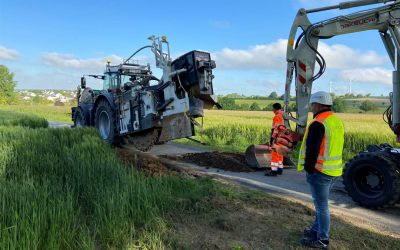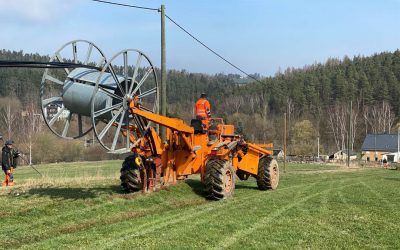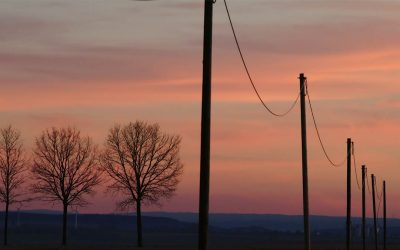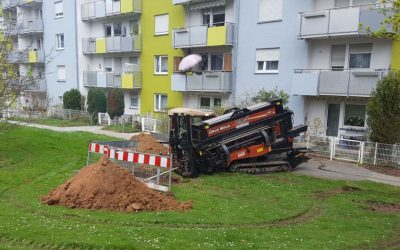In order to enable the expansion of fiber optic networks throughout Germany, the players involved have a variety of installation methods at their disposal. The methods must be selected according to topological characteristics and special project requirements.
Each installation method has its own limitations and application scenarios, which depend in particular on the surface conditions, the existing infrastructure and the length of the route to be laid. According to the federal government’s material concept, the joint use of existing infrastructures and the use of alternative installation methods (trenching, above-ground installation, etc.) must be examined and provided for.
In the course of implementing the subsidized construction project, all measures should be used that make it unnecessary to reopen the trench on all routes constructed as part of the subsidized project. The preparatory measures – for buildings that are not immediately developed in the current construction project – should be designed as far as possible in such a way that no excavation work in the public road space is necessary along the subsidized trench in the further course. Any building gaps, i.e. undeveloped plots between built-up areas, should be prepared for future infrastructure development via the subsidized construction measure.
Where which technology can and should preferably be used depends on the local conditions and must be agreed with the responsible road construction authority. Another important aspect is the cost of the construction work. Up to now, laying has accounted for up to 80 percent of the costs of an expansion project. Classic civil engineering includes the laying of fiber optic cables or empty conduits in the roadway or sidewalk area in urban and rural areas. It usually involves a massive opening of footpaths and cycle paths and always involves the removal and reuse of materials (paving, slabs, etc.). Classic civil engineering is suitable for routes without pre-existing infrastructure as well as with existing infrastructure. However, it usually takes longer, requires more manpower and therefore costs more than alternative installation methods. These include
- Press drilling (earth rocket)
- (Cable) plow
- Flushing hole
- Trenching
- Above-ground installation method
- Laying in water pipes
The aim of all alternative installation methods is to minimize civil engineering costs while increasing the installation speed. In order to make efficient use of the available civil engineering capacities, to minimize disruption to traffic and local residents and to speed up the gigabit expansion, the most suitable installation method must be selected for each construction project and agreed with the responsible authorities.
BMDV brochure: “Installation methods for gigabit expansion”
https://bmdv.bund.de/SharedDocs/DE/Artikel/DG/verlegetechniken-breitbandausbau.html
Our “Alternative installation methods” series
DIN 18220 comes into effect – Alternative installation methods standardized
DIN 18220 comes into force on July 28. The full name of the standard is "DIN 18220:2023-08. Trenching, milling and ploughing methods for laying empty conduit infrastructures and fiber optic cables for telecommunications networks" and describes in detail the methods...
Robots lay fiber optics in the sewer
An employee prepares the robot for use. Between 100 and 250 meters of fibre optic cable can be laid in this way per day. (Source: Fast Opti-com) Laying fiber optic cables in sewage pipes using robots is one of the alternative installation methods. These offer many...
Using traditional technology for a future-proof broadband connection: the plowing method as an alternative laying technique
The cable plow in use on a field. At the top left is the empty conduit, which is unwound from the drum and then laid in the freshly plowed furrow Photo: IBZ Neubauer When implementing broadband projects, different methods are used to lay the fiber optic cables. In...
Above-Ground Fibre Optic Installation – a Fast and Cost-Effective Alternative to Traditional Underground Construction
Photo: Adobe Stock When implementing broadband projects, different methods are used to lay the fibre optic cables. In contrast to "classic" civil engineering, in which an open trench is dug and the pipes are laid at least one meter deep, alternative laying techniques...
Trenching – Faster and More Efficient Nationwide Fibre Optic Expansion through Narrow Trenches
The Layjet laying fibre optics at Lake Möhnesee in the district of Soest (NRW)Photo: Kreis Soest / Christoph HellmannWhen implementing broadband projects, different methods are used to lay the fibre optic cables. In contrast to "classic" civil engineering, in which an...
The Flush Drilling Method – with High Pressure during Fibre Optic Installation
Entry point of the directional drilling on a meadow - the drill pipe, which aims diagonally into the ground, is clearly visible Photo: IBZ Neubauer When implementing broadband projects, different methods are used to lay the fibre optic cables. In contrast to "classic"...






